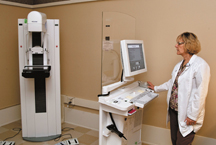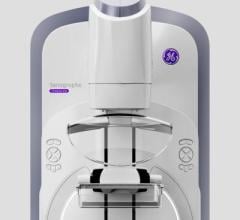
Patient comfort and cutting edge technology is important to Kern Radiology. That is why they chose Hologic as a vendor for many of their women's imaging needs.
At Kern Radiology Medical Group in Kern County, CA, revolutionary imaging technology and quality patient care go hand in hand. Its brand new, all-Hologic women’s imaging center gives patients access to the latest in digital mammography and breast biopsy technologies in a comfortable, spa-like setting. According to radiologist and president David Schale, M.D., their strong commitment to patient care is the reason the medical group spares no expense when it comes to technology.
“This is a small community, and our patients also happen to be our friends and family. We see them at the grocery store, at church, at our children’s soccer games,” he said. “We go the extra mile and spend the extra dollar because it’s in their best interest – that’s just how we do business.”
Staying Ahead of the Curve:
A Policy for Decades
Staying ahead of the technology curve has been the rule at Kern Radiology Medical Group since its opening 40 years ago. In the 1970s, it was the first facility in the nation to offer outpatient CT imaging. More recently, it was the first to introduce the dual-source 128-slice CT scanner to central California. In 2008, the Kern Radiology Outpatient Imaging Center opened with the county’s first Hologic Selenia digital mammography systems and the Selenia Digital StereoLoc II breast biopsy device. The new center also upgraded its bone density screening with the addition of a Hologic Discovery C system.
With the Digital StereoLoc II, Kern Radiology Outpatient Imaging is the only center in the county that performs upright breast biopsies. While other facilities mainly perform prone biopsies, Kern Radiology believes upright procedures enhance patient comfort and offer greater flexibility in the types and locations of lesions they can accommodate.
The speed of the new equipment further adds to the comfort of the procedure.
With no films to process, automatic needle positioning and a quick transition from mammography to biopsy, an average procedure with the Digital StereoLoc II lasts just under one hour – a significant improvement over their previous upright equipment.
“Patient comfort is important to us. Lying prone for a long period of time can be hard on patients, so that’s why we chose the upright option. The StereoLoc has also dramatically reduced the length of our biopsy procedures, which makes it even easier on patients,” said mammography supervisor Wendy Hendricks.
Dr. Schale performs up to five biopsies per day, a figure he estimates is greater than the rest of the imaging community combined. Despite the high volume, they are often able to offer the convenience of same-day biopsies, a service Dr. Schale always wanted the ability to provide for his patients. He attributes this accomplishment to both the center’s skilled staff and the considerably shorter length of the procedures.
By utilizing the Selenia digital imaging receptor, Digital StereoLoc II offers the same superior image quality, which enhances the accuracy of the procedure. In fact, when localizing abnormalities for biopsy, Dr. Schale notes that they can often visualize lesions that went undetected on diagnostic images sent from referring institutions.
“The accuracy of the equipment is amazing. We’re able to visualize more abnormalities and localize lesions better,” said Dr. Schale. “We didn’t even realize what might be missed until we could see such detail on the StereoLoc. It’s vastly superior to anything we’ve had before.”
The new technology helped Kern Radiology earn the only local ACR accreditation in sterotactic biopsy plus a reputation as the premier location for stereotactic breast biopsies in and around Bakersfield. The equipment’s versatility allows them to accommodate a wider range of patients, including those from competing facilities.
“With the StereoLoc, we can access more lesions, which means we’ve had to turn away fewer procedures. We’ve actually had patients come from other facilities that were unable to localize the lesions, and our equipment enabled us to successfully biopsy the areas of concern,” said Dr. Schale. “I think both physicians and patients hear how skilled we are at biopsies and women end up coming here, even if they had their initial imaging at another facility.”
Part of the excellence Kern Radiology is known for results from the continual effort to improve the patient experience. As mammography supervisor, Hendricks personally calls every biopsy patient the day after the procedure to assess their experience and solicit feedback. The majority of responses are overwhelmingly positive, she said.
Going Digital for the Future
Along with the Digital StereoLoc II, Kern Radiology brought the first Selenia digital mammography systems to Kern County. Though its original imaging center location still utilizes film-screen technology, they are in the process of installing a Selenia system at that site. In the future, Dr. Schale hopes to replace all of the group’s film-screen equipment with digital technology.
“Now that I’m reading digital images just about every day, I realize I can see so much more than I do on film, particularly with dense breasts. I feel that I’m doing a better job for the patient with a digital system,” he said.
The Hologic SecurView DX diagnostic workstation and R2 CAD also contribute to the quality of care they can provide with digital mammography. With outstanding image quality and the ability to manipulate images in multiple ways, the technology increases diagnostic confidence for the radiologists.
Despite his emphasis on cutting edge technology, Dr. Schale admits he was a late convert to digital mammography. Though he doubted the benefits of digital would outweigh the increased investment, there was never a question that the Kern Radiology Outpatient Imaging Center would be an all-digital facility. This was in preparation for the next major mammography innovation: digital breast tomosynthesis.
Tomosynthesis uses digital technology to capture a series of images of the breast that are then reconstructed into a three-dimensional image. Conventional mammography produces two-dimensional images, which can cause tissue overlap that obscures areas of concern. Tomosynthesis provides a variety of benefits, including better detection and fewer recalls.
“As far as I can tell, tomosynthesis just blows everything else out of the water. We decided to get digital now so we could be on the forefront of tomosynthesis when it comes out. Tomosynthesis is the next big thing, and that’s exactly where we want to be,” Dr. Schale said.
Quality Patient Care Requires More Than Technology
Kern Radiology knows that creating a positive patient experience requires more than simply offering the latest technology. They know quality patient care is an ongoing process, one that begins long before the patient steps into the exam room. The new imaging center was designed to create a spa-like atmosphere, complete with comfortable dressing rooms and waiting areas, as well as a unique private women’s area to maximize comfort and relaxation.
“We provide significantly more in the way of patient comforts than anyone else in the area. It’s the kind of place people expect to find in Beverly Hills, not California’s Central Valley,” said Schale. “Women, especially from more rural areas, are stunned when they see it.”
As a company that places a high priority on customer relationships, Kern Radiology Medical Group appreciates the level of service they receive from Hologic. During the digital installation, Hologic employees were readily available to answer questions or provide in-person technical support. What really appealed to Dr. Schale, however, was the easy access to all Hologic employees, from applications specialists to the CEO.
“We’ve had a very personal experience with Hologic. If we have a problem, they make their executives readily available to us,” said Schale. “In my experience, for a company of its size to do that is truly unique. You just can’t get that with any other company.”


 December 17, 2025
December 17, 2025 









